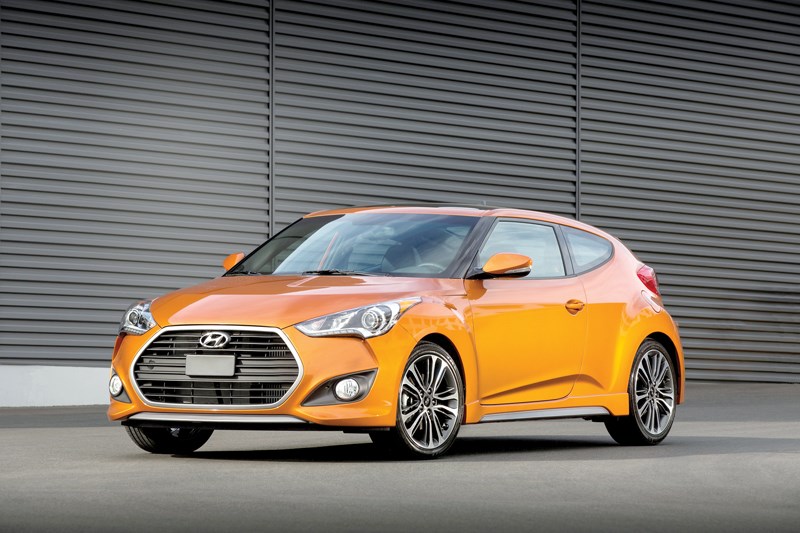The asymmetrical Veloster hatchback has got to be one of the quirkiest machines on the market.
It’s shaped a bit like one of those overstuffed skateboarding shoes, and has three doors: two normal ones up front and a little vestigial one on the right rear for backseat passengers.
When it launched, Hyundai made a lot of noise about the Veloster being a return of the sporty hatchback. Not so much – it was more a fancy looking Elantra, with soft handling and modest power. Decent on fuel though.
However, here’s the Veloster Turbo, which, if the name isn’t a dead giveaway, comes with more power. Does bolting on some forced induction and tuning up the suspension add a little sport into Hyundai’s littlest hatchback? Let’s find out.
Design
Human beings like symmetry. It’s hardwired right into our brains to seek it out. Thus, you’d expect the Veloster’s odd three-doored layout to be jarring – but it weirdly isn’t.
Perhaps it’s because you spend most of your time looking at that massive grille. Like every other car on the market, the Veloster has succumbed to Gawping Grille Syndrome (GGS), and looks a bit like a trout about to hoover down a hapless water beetle.
All the elements to make this a really sporty trout are here: standard 18-inch alloys, gaping rear twin-pipe exhaust, projector headlights with LED accenting, and unique side sills. The Veloster Turbo may be an oddball, but it’s a speedy looking thing.
Environment
The interior is similarly strange-yet-sporty, and features unique, angular grab handles for the doors. The seats have very large bolstering, and say “Turbo” right on them, just in case you forgot.
The rest of the interior is based around the flying-V vents that surround the infotainment centre. The seven-inch touchscreen works perfectly well, but is getting a little dated. It plays a little tune for you when you start or stop the car.
Cargo space is ample, albeit with a large sill for you to haul things over. Rear seat space is fine for the kids, or good enough for shorter adult passengers in a pinch.
Performance
The big recent change to the Veloster Turbo isn’t the addition of turbocharging, but its new seven-speed dual-clutch transmission. I’m afraid we have a little bad news here.
But first, the good stuff. The Hyundai’s 201 horsepower turbocharged 1.6-litre engine is feisty and fun, and the equal of that found in the Ford Fiesta ST. It makes peak power at 6,000 r.p.m., and a solid 195 foot-pounds of torque from just 1,750 r.p.m.
That kind of power in a light little front-driver should be a blast, and the Veloster Turbo does indeed deliver some pretty decent cornering and acceleration figures. However, the variable-weight steering delivers almost no feedback at all, so the driver doesn’t really have the confidence to go snaking up their favourite backroad.
As a highway car, the Veloster makes a lot more sense, with decent passing power and a comfortable ride. However, the seven-speed dual-clutch transmission needs a little dissection.
Most dual-clutch gearboxes deliver crisp, quick shifts that provide superior driver engagement. If engagement is what you’re looking for, Hyundai will sell you a six-speed manual in your Veloster Turbo.
More work needs to be done programming the seven-speed. Especially when cold, it has a tendency to hold in neutral and often takes too long to downshift and go. Turbo lag from the Veloster’s punchy engine isn’t a problem, but transmission lag is.
So, the Veloster Turbo displays essentially the same cruiser-first characteristics as the base car, just with more power and cornering. It’s an interesting proposition, but not a replacement for a Mini Cooper S or a VW GTI.
Features
If the Veloster Turbo isn’t a track special, it really shines in the feature department. Almost everything is standard on this little car, from leather seats to touchscreen navigation to heated seats and a heated steering wheel.
At $28,699 to start, that’s pretty good value, getting you a loaded-out car for the same price as base versions of traditional performance choices. There’s even a standard panoramic sunroof.
Fuel economy is solid. Official ratings are 8.9 (litres/100 kilometres) in the city and 7.1 on the highway. Real world results are pretty close to the official figures.
Green light
Quirky looks; solid power; surprisingly practical layout.
Stop sign
Clunky automatic; numb steering; aging platform.
The checkered flag
Asymmetrical to behold, but still has some charms.
Competition
Subaru WRX: As a counterpoint to the Veloster’s asymmetrical appeal, check out the symmetrical all-wheel drive of the Subaru WRX. Sales have been on a tear of late, thanks to the addition of a CVT automatic option after years of manual-only.
Like Hyundai’s dual-clutch, a CVT isn’t really the performance enthusiast’s choice. Subaru, however, has been able to program some fun into their offering, and if it still feels a little rubber-bandy from time to time, it’s also a slingshot.
The WRX is more expensive than the Veloster Turbo, and if you stretch to make the payments, you’ll be leaving some of those amenities behind. Still, if performance is your bag, the WRX’s added power and traction are hard to ignore.



